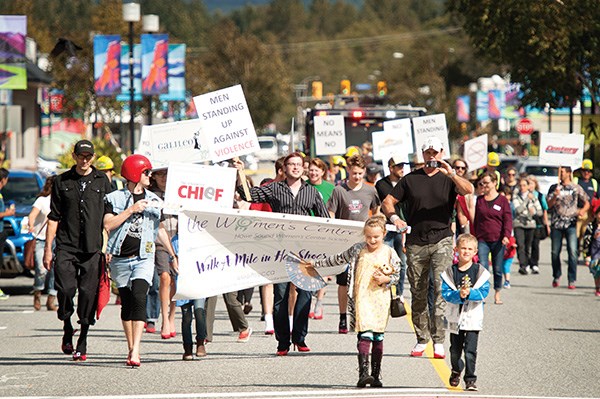Teetering in red stilettos, a group of men marched down Cleveland Avenue on Sunday (cover photo and page A25) to help end violence against women.
Around 40 men – trying their best to balance in high heels – took part in Walk A Mile In Her Shoes, an annual event in Squamish, to raise money for Howe Sound Women’s Centre Society.
Despite the seriousness of the topic, it was a family-friendly day that occurs across North America in support of a safer, more equitable and violence-free society for women and girls.
Violence against women is still prevalent in Canada, despite the issue being brought to the forefront more often.
Half of all Canadian women have experienced at least one incident of physical or sexual violence since the age of 16, according to the Canadian Women’s Federation.
This per cent is far too high, especially in 2016 when many other forms of violent crimes have decreased.
To make matters worse, 67 per cent of Canadians say they personally know at least one woman who has experienced physical or sexual abuse.
And the prevalence of the worst of crimes – murder – is shocking, especially since our country tends to be referred to as a polite and peaceful nation.
Around every six days, a woman in Canada is killed by her intimate partner. Out of the 83 police-reported intimate partner homicides in 2014, 67 of the victims – over 80 per cent – were women.
There were 1,181 cases of missing or murdered aboriginal women in Canada between 1980 and 2012, according to the RCMP. But, according to grassroots organizations and the Minister of the Status of Women, this number is closer to 4,000.
New forms of violence have emerged lately, including online threats, harassment and stalking. Young women aged 18 to 24, according to the Canadian Women’s Federation, are most likely to experience online harassment in its most severe forms.
Despite these sobering facts, there have been improvements. Police-reported domestic violence has gradually fallen because of increased social equality and financial freedom for women, which makes it easier for them to escape abusive relationships early on.
It’s also due to the hard work of groups like the Howe Sound Women’s Centre Society, which has 32 employees and dozens of dedicated volunteers who help women and their families with crisis support, outreach services, emergency transition housing and counselling.
Violence against women needs to stop and it will take both men and women – and the entire Squamish community – to put an end to it.
It can be sometimes be difficult to label your partner’s hurtful behaviour as abuse. To learn about the warning signs, go to hswc.ca./need-help-2/warning-signs.



